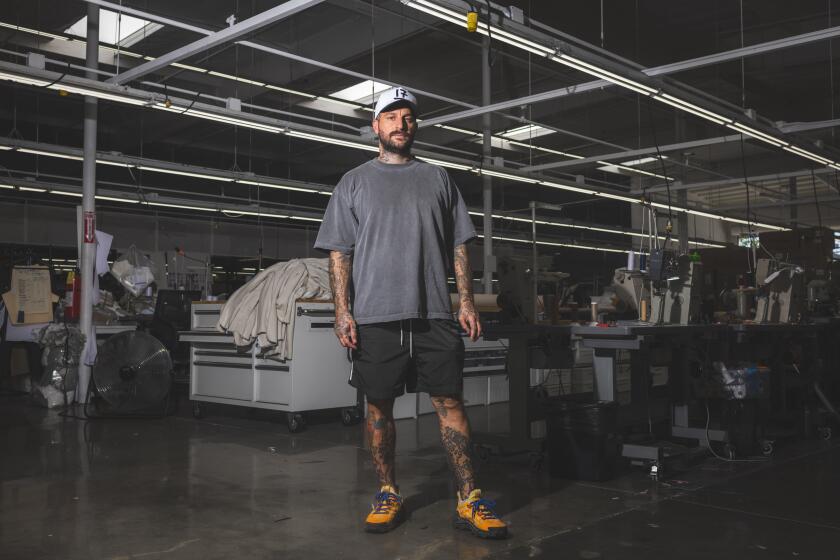Cancer risk from cellphone use is still a matter for study
CALIFORNIANS who use hands-free cellular devices while driving may be doing themselves a favor in the long run.
That’s because scientists still can’t say with certainty that placing a cellphone against the head is completely safe, especially for heavy users and people who began using the devices as children. They point to lingering questions over the potential health effects from the energy emitted by the phones, specifically the long-debated risk of developing brain cancer.
“It’s fair to say that the data aren’t all in yet,” says Dr. David L. McCormick, a biologist and director of the Illinois Institute of Technology Research Institute in Chicago, who has studied the issue. “There are a small number of epidemiological studies that have suggested a possible increase in cancer risk. But comparable studies in other populations haven’t confirmed these findings.”
That’s not to say anyone should panic. Cellphones do produce a type of radiation, but it’s of the type called nonionizing radio frequency -- a form of energy located on the electromagnetic spectrum. At the high end of the spectrum, ionizing radiation, such as that emitted by X-ray machines, has well-known dangers. But the weak signals released by nonionizing radio frequencies do not cause DNA damage, and there is no explanation for how such energy could cause cancer, McCormick says.
Most studies have not consistently demonstrated a link between cellphone use and cancer, including two studies conducted by the National Cancer Institute. Several other studies coordinated through the International Agency for Research on Cancer, called the Interphone studies, have also failed to show an association. Numerous laboratory studies on animals have also found no evidence that DNA is damaged by low levels of radio frequency, McCormick says.
But the sheer number of people now using cellphones and the volume of use, as well as a few studies that found a potential link between brain cancer and cellphones, have kept the safety question looming.
‘Unexpected results’
The National Academy of Sciences released a report in January calling for more research on cellphones and health risks. The authors concluded that many of the past studies were not conducted over a long-enough period of time to assess the risk of brain cancer, which typically develops slowly.
Nor have the studies examined the effects of cellphone use on children, whose nervous systems are still developing, or on whether the radio frequency emissions can cause other types of health problems, such as cancers elsewhere in the body or central nervous system damage that may affect learning or behavior, says Dr. Leeka Kheifets, a professor of epidemiology at UCLA’s School of Public Health, who was a member of the NAS panel.
“At this point, it looks unlikely that cellphones are causing brain tumors, particularly from short-term exposures,” says Kheifets. “But we have not looked at all kinds of health outcomes yet. The focus has been on brain tumors because exposure from cellphone use is mostly to the brain. And we are just beginning some studies on brain cancer in children.”
Kheifets and researchers in Denmark recently examined cellphone use in children and found “unexpected results.” The researchers examined 13,159 Danish children born in 1997 and 1998 who are participants of a study called the Danish National Birth Cohort. The children’s mothers were surveyed during pregnancy and again when the children were 18 months old and 7 years old.
The study found that children who used cellphones, and whose mothers used cellphones during pregnancy were 80% more likely to have behavioral problems such as emotional symptoms, inattention, hyperactivity and problems with peers compared with children who had no cellphone exposure as fetuses or in early childhood. Children whose mothers used cellphones during pregnancy but who had no other cellphone exposure were 54% more likely to have behavioral problems.
The study, which will be published next month in the journal Epidemiology, is the first to find a behavioral effect and so must be interpreted with caution. But Kheifets says, “In general, children are more susceptible to environmental hazards. We have little information on cellphones, and children are using cellphones at younger ages. A lot of families now don’t even have a land line.”
Research on children and long-term studies should provide more clarification on any health risks, says Dr. Siegal Sadetzki, an epidemiologist at Gertner Institute, Chaim Sheba Medical Center, in Israel.
Sadetzki’s research has found heavy cellphone users were at 50% higher risk for a parotid tumor, which arises in the salivary gland near the ear and jaw, typically where cellphones are held. Parotid tumors can be cancerous or benign. The study was significant because it tracked heavy users for more than 10 years and found a relationship between the side of the head the phone was typically placed against and where the tumor formed.
She says she doesn’t think her study, which was published in February in the American Journal of Epidemiology, contradicts previous studies that showed no cause for alarm. The research was conducted in Israel, which has a population of heavy users who were among the first to adopt cellphone technology.
“Most negative results were seen for short-term users, below 10 years of use,” she said in an e-mail interview. “It is well known that the latency period for cancer development, and certainly for brain tumor development, is longer than that. The problem is, of course, that we are dealing with a relatively new technology.”
Building controversy
Besides the recent studies that have found some cause for concern, the controversy over cellphone safety was stoked recently when an Australian neurosurgeon published a paper on the Internet saying phone use “has far broader public health ramifications than asbestos and smoking.”
The doctor, Vini Khurana, analyzed data from more than 100 studies, concluding that most weren’t long enough to uncover a risk of brain cancer and that children haven’t been adequately studied. His Internet paper and recent appearance on CNN’s “Larry King Live” show rankled some health experts because of his alarming stance.
“The position he took was rather extreme,” says McCormick. “
King’s show was followed the next day with a blog posting on CNN.com by the network’s chief medical correspondent, Dr. Sanjay Gupta, who also appeared on the show. The item cast doubt on cellphone safety and noted that both Khurana and Dr. Keith Black, a neurosurgeon at Cedars-Sinai Medical Center who appeared on King’s show, use hands-free cellphone devices.
A spokesperson for Black says he is no longer commenting publicly on potential cellphone hazards.
Says Sadetzki: “I believe that the cellphone technology has a lot of advantages and is here to stay. But we, as a society, need to decide how to use it. . . . I think that the precautionary principle advising the use of simple measures to lower exposure should be adopted and taken seriously.”
More to Read
Inside the business of entertainment
The Wide Shot brings you news, analysis and insights on everything from streaming wars to production — and what it all means for the future.
You may occasionally receive promotional content from the Los Angeles Times.










